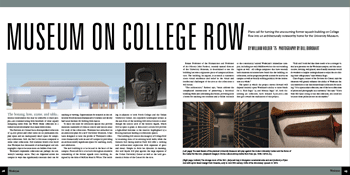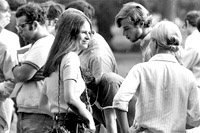Museum on College Row
 THE BONANG, KOTO, AXATSE, AND TABLA–musical instruments that may be unknown to many people–are crammed along with hundreds of other equally intriguing items from the World Music collection in a locked storeroom smaller than many dorm rooms.
THE BONANG, KOTO, AXATSE, AND TABLA–musical instruments that may be unknown to many people–are crammed along with hundreds of other equally intriguing items from the World Music collection in a locked storeroom smaller than many dorm rooms.
The Davison Art Center has a distinguished collection of 25,000 prints and other items yet no permanent display space and an inadequately small space for temporary exhibitions. Still, the DAC is fortunate compared to some other collections. Few students would even know that Wesleyan has thousands of archaeological and ethnographic objects because most are hidden from view.
Wesleyan’s impressive collections are perhaps the university’s best-kept secret. They are dispersed across the campus in ways that significantly constrain their use for teaching or viewing. Opportunities for research in the collections would increase dramatically if students and faculty had better facilities for working with objects.
To meet the need for exhibition spaces that provide museum standards of climate control and secure areas for study of the collections, Wesleyan has embarked on an ambitious plan for a new University Museum. It has been designed to raise the profile of Wesleyan’s collections dramatically both on and off campus by providing an architecturally significant space for teaching, study, and exhibition.
The new building is to be located in the heart of the campus. Plans call for it to be built through an extensive remodeling of the former squash court building, designed by the firm of McKim Mead & White. The building is adjacent to both North College and the Usdan University Center. An expansive landscaped terrace at the east front of the building will invite visitors to enter though the central arch of the historic facade, which will be open to glass. A three-story atrium will provide a light-filled welcome to the interior, highlighted by a floating staircase leading to exhibition spaces.
The building will ensure the integrity of College Row by retaining three of its existing brick walls, while the western wall facing Andrus Field will offer a striking new architectural expression with expanses of glass and metal. Simple in form but dynamic in massing, this new facade will play against the large expanse of the Usdan University Center as well as the bold geometrical forms of the Center for the Arts.
Kenan Professor of the Humanities and Professor of Art History John Paoletti, recently named director of the University Museum, is determined to see the building become a signature piece of campus architecture. The building, he argues, is as much a statement about visual excellence and belief in the visual and intellectual challenges of the arts as the collections it will house.
“The architecture,” Paoletti says, “must address the complicated intersections of preserving a historical building while also addressing the future, providing both a home for teaching our students and a visible outreach to the community beyond Wesleyan’s immediate campus, including not only Middletown but the surrounding region as well. All college campuses that have recently built museum structures have found that the building, its collections, and its programs provide a center for activity on campus as well as visually striking publicity for the institution as a whole.”
The speed at which the project moves forward will depend entirely upon Wesleyan’s ability to raise funds for it. Rick Segal ’75 and Monica Mayer Segal ’78, both discerning art collectors, have donated $500,000–the first gift toward the realization of this project.
“Rick and I both feel that there needs to be a stronger visual arts presence on the Wesleyan campus, and that an attractive, inviting, well-placed, user-friendly museum would do wonders to inspire undergraduates to enjoy the arts during their college years,” says Monica Segal.
Clare Rogan, curator of the Davison Art Center, says the museum will greatly enhance the ability of Wesleyan faculty members to use this extraordinary collection for teaching. “It’s a spectacular collection, one of the best collections of prints and photographs at a university,” she says. “If you were Bill Gates trying to buy this collection, you could not because these prints are not on the market.”
During the past 50 years, starting with George Davison’s initial gift of 6,000 prints and 300 drawings donated between 1937 and 1953, the DAC collection has grown to some 25,000 items. Among them are more than 18,000 European and American prints representing virtually all important printmakers from the Renaissance to the present, 600 Japanese prints, and more than 6,000 photographs, dating from the invention of photography to today.
Lack of space is constraining Rogan’s ability to augment the collection. Many current photographers, for instance, work in large formats, but current storage limitations make it a challenge to house large works.
Climate control is a critical aspect of the proposed museum. Wesleyan is unable to borrow works of art from other institutions because the DAC facilities do not meet modern museum standards, particularly for control of humidity fluctuations. In providing new spaces that address these conservation issues, the museum will give Wesleyan greatly expanded scope for mounting exhibitions, both from its own and other collections, that will perform important teaching functions as well as appeal to a broad public.
“The DAC is a lovely little gem,” says Rogan, “but it’s not a very well known gem, even within Middletown. The new museum will put a very dynamic public face on the visual arts and material culture at Wesleyan.”
In one respect, the plans for the museum are a reprise of Wesleyan’s history. In the 19th century Wesleyan’s Museum of Natural History was a leader among collegiate collections. George Goode, class of 1870, was the first curator. His national leaderships subsequently earned him a position at the Smithsonian. The museum, located on the top two floors of Judd Hall, was a repository for the Connecticut state archaeologist and held objects donated from alumni traveling and exploring worldwide. In 1877, it contained 115,000 mineralogical, paleontological, archaeological, and ethnographic specimens. By the 1930s, however, the rise of laboratory science had led this type of collection to fall from favor as a teaching tool. It was dismantled in 1957, and the objects were both dispersed across campus and given to other institutions, with some items going to Yale, the University of Connecticut, and the Smithsonian.
Today the university has nearly 30,000 items in its archaeology and anthropology collection, some of which were acquired in more recent times.
“Our collection contains objects of great pedagogical value,” says Professor of Anthropology and Archaeology Douglas Charles, “but it is woefully underutilized. In part this results from the invisibility of the collection on campus.” Most of the objects are stored in one room in Exley Science Center that was designed as a science lab–many are in old drawers or cardboard boxes.
The new museum would provide much-needed public exhibition space, including space for student-curated exhibitions, as well as proper storage, laboratory facilities for working with objects, and hands-on study space for students.
The Archaeology Program now has a part-time collections manager who has completed an inventory over the past five years. Students in several archaeology classes use the collection, but Charles says the potential for hands-on teaching has barely been tapped. The collections range from stone and bone artifacts from famous Paleolithic cave sites in Israel to intricately carved ceremonial items from the Pacific Islands; from prehistoric tools and other artifacts gathered in Connecticut to pre-Columbian figurines from Mesoamerica, as well as museum-worthy Greek vases and Roman coins. The collection also has benefited from faculty research in Middletown during the 1970s and 1980s that unearthed artifacts revealing local middle- and upper-class life in the 18th and 19th centuries.
Patrick Dowdey, curator of the Mansfield Freeman Center for East Asian Studies, also looks forward to the visibility that the University Museum could provide. The Freeman Center has an exhibition program in its small space, but its location on the outskirts of campus does not help foot traffic. “People drive by us every day and don’t know that we have exhibitions,” he says.
The center has a sizeable archive of materials dating to the 19th century, many related to the travels of missionaries and Chinese students who came to the United States. It has a collection of Japanese and Chinese paintings and calligraphy, historic garments that are highly sensitive to climate, numerous photographs, and Japanese toys. The center also houses all the papers of Mansfield Freeman ’16, who spent much of his life in East Asia; his bequest established the Freeman Foundation.
The need for a museum, though long known, surfaced more urgently in 1997 through the report of the Collections Advisory Committee, which strongly asserted that Wesleyan was beyond reasonable capacity for its collections and that responsible stewardship demanded higher standards of climate and light control. The report also addressed the compelling pedagogical need to give faculty and students better access to the objects in Wesleyan’s collections. As the report said: “The flash of understanding?when a student finally understands the complex process of building and firing a pre-Columbian pot, while holding the actual pot in her hands, simply cannot be replicated by any number of pages or reproductions.”
The building will contain a 115-seat auditorium for classes and lectures as well as reception space for events. Glass-enclosed spaces will provide visitors with views of the campus. A variety of exhibition spaces, accommodating both large-scale exhibitions and small focused study cases, will be available on the second and third floors. Ample storage, object study areas, labs, offices, and open storage areas that permit easy access to items, will ensure that the building serves the needs of faculty and students university-wide.
The project could have no better proponent than Paoletti, says Elizabeth Milroy, dean of the arts and humanities. “John has the passion and the vision, and he is a particularly eloquent advocate who is widely known among alumni. He and his colleagues have built one of the best art history programs at the undergraduate level in the country. He can be counted on to take the project and do something with it.”
A member of the faculty since 1972, Paoletti is an authority on Italian Renaissance art and modern art, a recipient of Wesleyan’s Binswanger Teaching Award, and is renowned for delivering challenging lectures. He is a regular participant in the speaker’s series at the Metropolitan Museum of Art in New York. Paoletti has seen the interest in the arts at Wesleyan and other institutions develop in extraordinary ways. And yet, Wesleyan has been without an appropriate museum facility comparable to its peers. He is most excited about the impact that the museum will have on Wesleyan’s educational programs.
“We’ve recently had sophomores and juniors who have had internships at the Museum of Modern Art, the Whitney Museum, the Frick Collection in New York City, the Museum of Fine Arts in Boston, and the Chicago Art Institute, just to name a few,” he says. “Many of our students have gone on to prestigious positions in the gallery and museum world and in academics. The new museum will improve our ability to provide more extensive teaching opportunities–not just for these students, but for students in every area of the university–and will give our educational programs a very public face to the world outside Wesleyan.”

